Related Research Articles
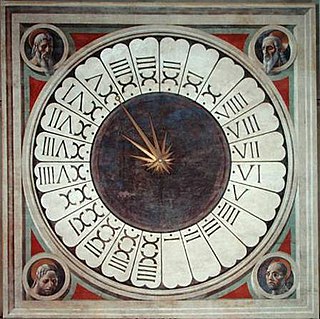
A clock or a timepiece is a device used to measure and indicate time. The clock is one of the oldest human inventions, meeting the need to measure intervals of time shorter than the natural units such as the day, the lunar month and the year. Devices operating on several physical processes have been used over the millennia.

John Harrison was a self-educated English carpenter and clockmaker who invented the marine chronometer, a long-sought-after device for solving the problem of calculating longitude while at sea.
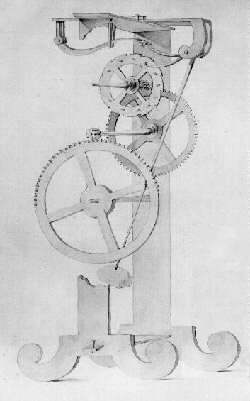
A pendulum clock is a clock that uses a pendulum, a swinging weight, as its timekeeping element. The advantage of a pendulum for timekeeping is that it is a harmonic oscillator: It swings back and forth in a precise time interval dependent on its length, and resists swinging at other rates. From its invention in 1656 by Christiaan Huygens, inspired by Galileo Galilei, until the 1930s, the pendulum clock was the world's most precise timekeeper, accounting for its widespread use. Throughout the 18th and 19th centuries, pendulum clocks in homes, factories, offices, and railroad stations served as primary time standards for scheduling daily life, work shifts, and public transportation. Their greater accuracy allowed for the faster pace of life which was necessary for the Industrial Revolution. The home pendulum clock was replaced by less-expensive, synchronous, electric clocks in the 1930s and '40s. Pendulum clocks are now kept mostly for their decorative and antique value.

The second is the unit of time in the International System of Units (SI), historically defined as 1⁄86400 of a day – this factor derived from the division of the day first into 24 hours, then to 60 minutes and finally to 60 seconds each.

A water clock or clepsydra is a timepiece by which time is measured by the regulated flow of liquid into or out from a vessel, and where the amount is then measured.

An escapement is a mechanical linkage in mechanical watches and clocks that gives impulses to the timekeeping element and periodically releases the gear train to move forward, advancing the clock's hands. The impulse action transfers energy to the clock's timekeeping element to replace the energy lost to friction during its cycle and keep the timekeeper oscillating. The escapement is driven by force from a coiled spring or a suspended weight, transmitted through the timepiece's gear train. Each swing of the pendulum or balance wheel releases a tooth of the escapement's escape wheel, allowing the clock's gear train to advance or "escape" by a fixed amount. This regular periodic advancement moves the clock's hands forward at a steady rate. At the same time, the tooth gives the timekeeping element a push, before another tooth catches on the escapement's pallet, returning the escapement to its "locked" state. The sudden stopping of the escapement's tooth is what generates the characteristic "ticking" sound heard in operating mechanical clocks and watches.

The vergeescapement is the earliest known type of mechanical escapement, the mechanism in a mechanical clock that controls its rate by allowing the gear train to advance at regular intervals or 'ticks'. Its origin is unknown. Verge escapements were used from the late 13th century until the mid 19th century in clocks and pocketwatches. The name verge comes from the Latin virga, meaning stick or rod.

Thomas Earnshaw was an English watchmaker who, following John Arnold's earlier work, further simplified the process of marine chronometer production, making them available to the general public. He is also known for his improvements to the transit clock at the Royal Greenwich Observatory in London and his invention of a chronometer escapement and a form of bimetallic compensation balance.
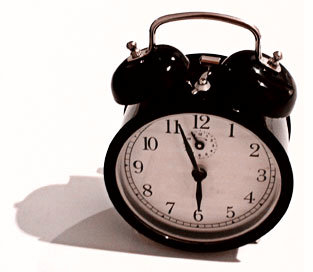
In sociology and anthropology, time discipline is the general name given to social and economic rules, conventions, customs, and expectations governing the measurement of time, the social currency and awareness of time measurements, and people's expectations concerning the observance of these customs by others.

An hourglass is a device used to measure the passage of time. It comprises two glass bulbs connected vertically by a narrow neck that allows a regulated flow of a substance from the upper bulb to the lower one. Typically, the upper and lower bulbs are symmetric so that the hourglass will measure the same duration regardless of orientation. The specific duration of time a given hourglass measures is determined by factors including the quantity and coarseness of the particulate matter, the bulb size, and the neck width.

An electric clock is a clock that is powered by electricity, as opposed to a mechanical clock which is powered by a hanging weight or a mainspring. The term is often applied to the electrically powered mechanical clocks that were used before quartz clocks were introduced in the 1980s. The first experimental electric clocks were constructed around the 1840s, but they were not widely manufactured until mains electric power became available in the 1890s. In the 1930s, the synchronous electric clock replaced mechanical clocks as the most widely used type of clock.
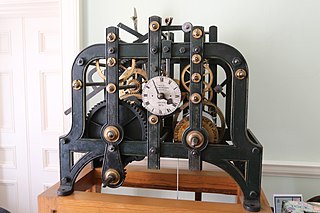
The British Horological Institute (BHI) is the representative body of the horological industry in the United Kingdom. It was founded by a group of clockmakers in 1858, and has its current premises at Upton Hall in Nottinghamshire, which includes a museum of clock history.

A marine chronometer is a precision timepiece that is carried on a ship and employed in the determination of the ship's position by celestial navigation. It is used to determine longitude by comparing Greenwich Mean Time (GMT), or in the modern world its successor Coordinated Universal Time (UTC), and the time at the current location found from observations of celestial bodies. When first developed in the 18th century, it was a major technical achievement, as accurate knowledge of the time over a long sea voyage was vital for effective navigation, lacking electronic or communications aids. The first true chronometer was the life work of one man, John Harrison, spanning 31 years of persistent experimentation and testing that revolutionized naval navigation and enabling the Age of Discovery and Colonialism to accelerate.

A chronometer is an extraordinarily accurate timepiece, with an original focus on the needs of maritime navigation. In Switzerland, timepieces certified by the Contrôle Officiel Suisse des Chronomètres (COSC) may be marked as Certified Chronometer or Officially Certified Chronometer. Outside Switzerland, equivalent bodies, such as the Japan Chronometer Inspection Institute, have in the past certified timepieces to similar standards, although use of the term has not always been strictly controlled.

The history of timekeeping devices dates back to when ancient civilizations first observed astronomical bodies as they moved across the sky. Devices and methods for keeping time have gradually improved through a series of new inventions, starting with measuring time by continuous processes, such as the flow of liquid in water clocks, to mechanical clocks, and eventually repetitive, oscillatory processes, such as the swing of pendulums. Oscillating timekeepers are used in all modern timepieces.

The Shortt–Synchronome free pendulum clock is a complex precision electromechanical pendulum clock invented in 1921 by British railway engineer William Hamilton Shortt in collaboration with horologist Frank Hope-Jones, and manufactured by the Synchronome Company, Ltd., of London. They were the most accurate pendulum clocks ever commercially produced, and became the highest standard for timekeeping between the 1920s and the 1940s, after which mechanical clocks were superseded by quartz time standards. They were used worldwide in astronomical observatories, naval observatories, in scientific research, and as a primary standard for national time dissemination services. The Shortt was the first clock to be a more accurate timekeeper than the Earth itself; it was used in 1926 to detect tiny seasonal changes in the Earth's rotation rate. Shortt clocks achieved accuracy of around a second per year, although a recent measurement indicated they were even more accurate. About 100 were produced between 1922 and 1956.

Quartz clocks and quartz watches are timepieces that use an electronic oscillator regulated by a quartz crystal to keep time. This crystal oscillator creates a signal with very precise frequency, so that quartz clocks and watches are at least an order of magnitude more accurate than mechanical clocks. Generally, some form of digital logic counts the cycles of this signal and provides a numerical time display, usually in units of hours, minutes, and seconds.
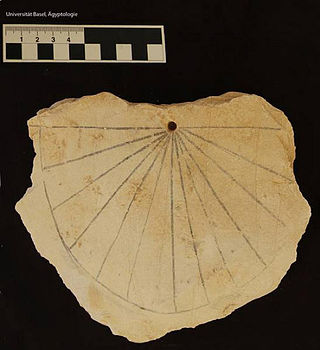
A sundial is a device that indicates time by using a light spot or shadow cast by the position of the Sun on a reference scale. As the Earth turns on its polar axis, the sun appears to cross the sky from east to west, rising at sun-rise from beneath the horizon to a zenith at mid-day and falling again behind the horizon at sunset. Both the azimuth (direction) and the altitude (height) can be used to create time measuring devices. Sundials have been invented independently in every major culture and became more accurate and sophisticated as the culture developed.
Time in the Kingdom of the Netherlands is denoted by Central European Time (CET) during the winter as standard time in the Netherlands, which is one hour ahead of coordinated universal time (UTC+01:00), and Central European Summer Time (CEST) during the summer as daylight saving time, which is two hours ahead of coordinated universal time (UTC+02:00). The Caribbean Netherlands – which consist of the islands of Bonaire, Sint Eustatius and Saba – all observe Atlantic Standard Time (AST) year-round, which is four hours behind coordinated universal time (UTC−04:00).
Warren A. Marrison was a Canadian engineer and inventor. Marrison was the co-inventor of the first Quartz clock in 1927.
References
- ↑ "Sundial". Encyclopædia Britannica . Retrieved April 4, 2008.
- ↑ "One of world's oldest sun dial dug up in Kings' Valley, Upper Egypt". ScienceDaily. 14 March 2013. Retrieved 10 May 2021.
- ↑ Barnett 1999, p. 18.
- ↑ Dolan 1975, p. 34.
- ↑ Bergreen 2003, p. 53.
- ↑ "Ancient Calendars". A Walk Through Time. National Institute of Standards and Technology. 12 August 2009. Retrieved 15 May 2021.
- ↑ Landes 1985, p. 220.
- ↑ Marrison 1948, p. 538.